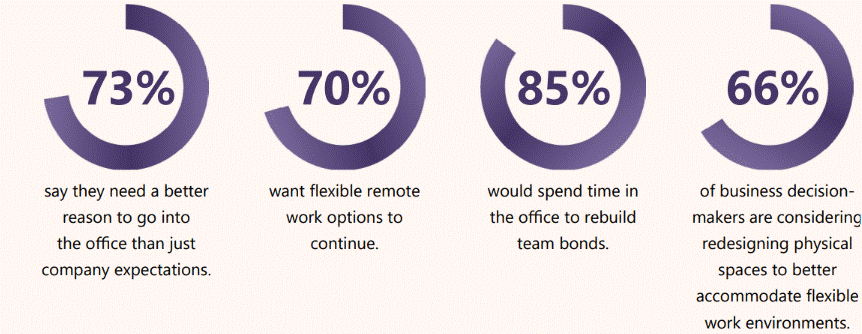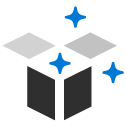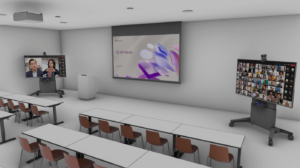Our guide for deploying and driving adoption of Microsoft Places
A how-to guide from Microsoft Digital sharing the lessons we’ve learned implementing Places to create a more flexible, efficient, and productive workplace.
Understanding the impact of flexible work
Flexible work is more than a trend—it’s a revolution in how we operate at Microsoft Digital, our internal IT organization here at Microsoft. We’re creating a workplace for 228,000 employees where flexibility isn’t a perk but a standard. This is about more than saving on office space—it’s about investing in our people. When we show that we care about their well-being, we see a boost in morale and productivity. It’s a win-win.
“We’re fully committed to flexible work here at Microsoft,” says Nathalie D’Hers, corporate vice president of Microsoft Digital. “Places is helping our employees function effectively when and where they choose to work.”
However, working remotely can lead to feelings of disconnection among employees. They miss the spontaneous interactions and informal conversations that often happen in a physical office. Our company research indicates that a significant percentage of remote-working employees feel isolated and disconnected from their teams, which negatively impacts morale and productivity.
Consider the results from global users polled about flexible work in our Work Trend Index Report:
- 73% say they need a better reason to go into the office than just company expectations.
- 70% want flexible remote work options to continue.
- 85% would spend time in the office to rebuild team bonds.
- 66% of business decision-makers are considering redesigning physical spaces to better accommodate flexible work environments.
Many businesses understand these pain points but find it difficult to manage and coordinate the logistics required to coordinate meaningful in-person interactions between teams in the flexible workplace.
Understanding the needs of hybrid workers

Meet Microsoft Places
Microsoft Places is our new AI-powered flexible workplace offering. Our employees are using Places to make sure that there are spaces available to achieve their goal for the day when they go into the office, and to know who else might be in going in that day who they can collaborate with. With Places, they can more easily book the right workspaces, coordinate work schedules with their team, and boost their in-person collaboration.
Our managers are also using Places to optimize where work happens and to get key insights that they can use for long-range planning.
Here are the key areas where Places is helping us provide value in new flexible work situations at Microsoft.
- Enhanced collaboration and productivity. Places provides a platform for employees to collaborate and be productive, whether they’re working remotely or in the office. It helps build authentic relationships, trust, and unity among team members.
- Seamless integration with Microsoft 365. Places integrates seamlessly with Microsoft 365, allowing users to coordinate their work schedules and locations through the new calendar in Outlook and Teams. For example, our employees can quickly see the location and status of their peers from the people card, anywhere in Outlook or Teams. This integration helps them plan their workdays more effectively in the flow of work.
- Improved employee experience. By providing a more modern workplace environment, Places enhances the overall employee experience. Using Places, our employees can see where their colleagues are working and plan in-person meetings more effectively.
- Cost and space optimization. Places helps us optimize our office space and reduce our costs by understanding work patterns and suggesting space improvements with occupancy and utilization data. This ensures that physical spaces are used efficiently and meet the needs of our flexible workforce.
We’ve deployed Places across 15 Microsoft campuses worldwide, making Places’ full functionality available to almost 12,000 employees. They’re using it to:
- Check the location and workplans of collaborators in the flow of work from Microsoft 365 apps.
- Find and book workspaces using Places Finder.
- Get a singular view of the people, spaces, and experiences at each workplace location and search for workspaces and locations they’re interested in.
- Use Copilot to get workplan guidance that they can use to create flexible work schedules that coordinate with the schedules of their collaborators.
We’re learning a lot from employees who are using Places by working with them through deployment and adoption. Our goal with this guide is to share our learnings with you. Our mission at Microsoft Digital is to empower, enable, and transform the company’s digital employee experience across devices, applications, and infrastructure. We hope you’ll find this guide helpful in deploying and adopting Places at your company.
{Download an eBook version of this Microsoft Places readiness guide.}
Chapter 1: Assessing the need for Microsoft Places
Meeting the challenges of the flexible workplace
Before you begin, you should consider how flexible work is impacting your business and your employees. While flexible work inefficiencies are a primary driver for implementing Places, challenges in coordination, modernization, and optimization will affect how you plan for and deploy Places.
Identifying key challenge areas
We’ve identified three main flexible work challenges to plan for when adopting Places:
- Coordinating flexible work plans. Facilitating high-quality in-person connections in a flexible work environment can be tedious, time-consuming and thankless. We refer to this as the “coordination tax”—the extra time, effort and energy required to coordinate high-value connection opportunities.
New AI-powered features across Places, Teams, and Copilot triangulate across calendars, location plans, and team guidance to make it quick and easy to plan in-person touchpoints with colleagues. - Modernizing your workplace experience. When employees are in the office, understanding their coworkers’ workplace locations and having access to space that facilitates inclusive meetings is imperative. Modernizing physical work environments means designing them with the right technology to accommodate flexible work. Enabling employees to establish and update their workplace presence plays an important role in facilitating effective real-time collaboration and spontaneous connection.
- Optimizing workspace usage. The rise in flexible work models has created specific challenges for IT and facilities administrators. Optimizing real estate portfolio mixes, office layouts, and technology starts with understanding utilization—and, more importantly, what’s driving it. Devices that help capture a range of utilization signals are invaluable in determining the effectiveness of your optimization efforts.
Building a foundation for Microsoft Places by assessing challenges
Laying the framework for an effective Places implementation begins with assessing the current flexible work environment and aligning any challenges with potential solutions in Places and identifying how your initial Places pilot will run. Our process included the following:
- Identify key business areas and stakeholders. Identify the value that Places can bring to each challenge and identify potential sites and organizational leaders who are active adopters of flexible workplace experiences. For optimal adoption, we identified three sponsorship levels:
- Human resources should sponsor flexible work initiatives
- Facilities leaders should sponsor implementation at the region and building level
- Organizational leaders for each of the key components should sponsor their specific area.
- Look for opportunities like significant changes in building occupancy, new buildings, or renovations that might help encourage employees to come back to the office to meet in person.
- Build a network of sponsors and champions. Focus on avid adopters, those with flexible workplace experience, and members of your organization who can help encourage widespread use of Places capabilities. The sponsors and champions are the key to driving adoption and scaling your adoption practices.
- Prepare for data onboarding. You need data about your spaces to implement Places successfully. Information about your buildings, floors, and floorplans will help you get the most out of Places features. Start with buildings that have this data readily available, and you’ll be able to launch your pilot more quickly.
- Build for collaboration and feedback. Places is about improving the experience your employees have when they go into an office for work, and you need to have mechanisms in place to measure and assess that experience. Comprehensive feedback will help you understand and experiences of your pilot participants and make improvements. As you continue the rollout, the system you set up at the start will enable you to continue measuring and evaluating the implementation for the entire organization.
- Document everything, including planning, data, feedback, and insights. Documenting your initial processes and results will help you establish improvements, modernize processes, and scale up to wider implementation when the time comes.
Flexible work is inherently complex. Schedules are dynamic and often not uniform among individual team members, let alone separate teams. Properly assessing the dynamics of the flexible workplace requires looking closely at the specifics of individual personas in addition to developing a broad view of general workplace dynamics in your organization.
Generating broad and deep usage data with individual personas
Personas help to identify specific patterns and use cases for Places among common roles in your organization. Building out a set of personas provides a concrete list of behaviors, needs, and pain points to use when implementing Places. Personas also create a window into your users and ensure that these behaviors, needs, and pain points are accurate and relevant for the roles they represent. Personas can help you anticipate use cases, challenges, and benefits when planning your Places implementation.
Here are three personas from our core user groups that highlight the information you should be collecting to develop personas for your planning:

Aadi Kapoor—marketing coordinator
Aadi has been working remotely since COVID-19 and the advent of hybrid work. He enjoyed his newfound flexibility during the pandemic but now feels disconnected from his coworkers and is worried that his growth is being stagnated by the lack of diversity in his work and connections.
He wants to come into the office for improved collaboration and connection but doesn’t know what activities would make it worth commuting in or how to choose the best times.
Here’s how we can help Kapoor:
- Optimize his in-office days by effectively using the benefits and amenities of the physical spaces.
- Build out his professional network and connection with his team.
- Collaborate effectively when working in the office.
Kapoor can use Places to input his work plan to create visibility and encourage others to communicate their in-office days. This usage pattern will help maximize collaboration and connection time.

Mona Kane—HR manager
Kane is the manager of a small flexible team and is very passionate about being a good leader and mentor to support the professional growth of her direct reports.
She enjoys the office environment and tries to work in the office at least three days per week. While she appreciates the benefits of flexible work, she has concerns about her ability to manage her team effectively because many work remotely most days.
Here’s how we can help Kane:
- Foster a healthy team culture of trust, connection, and belonging.
- Respect the lifestyle needs of her direct reports while adhering to the policies of her organization.
- Ensure her team stays productive and maintains a balanced workload.
Kane can use Places to share work location policy suggestions and recommend team meetings events on select days. She can use Places to understand if her team is OK with the days she’s suggested for them to come into the office. She can suggest team building events for the days when most of her team is in the office to build a cadence for in-person days.

Serena Davis—facilities portfolio manager
Davis has been with the company for over a decade and is extremely competent in her role. She has a deep understanding of the tools and processes associated with managing the physical office spaces and the gaps and limitations in the technology that impact her ability to more effectively plan for her company’s real estate needs.
Here’s how we can help Davis:
- Monitor space utilization, building attendance, and so on to communicate space needs to the business.
- Ensure that the Facilities department provides an appropriate number and types of meeting spaces for people coming into the office.
- Ensure that spaces have the appropriate equipment and amenities.
As employees begin to onboard into Places, even with a small amount of data, Davis can already see trends that help her better understand building utilization needs for each team. She can share this data with her leaders so they can start having conversations grounded in what is currently happening in their spaces.
Properly assessing the state of flexible work at your organization is instrumental in planning and launching a pilot deployment that will effectively demonstrate the benefits of Places for your organization. By following our recommendations and using the assessment building blocks we’ve mentioned, you’ll be ready to decide how and where to implement Places in your organization to best benefit employees and the broader organization.

How we did it at Microsoft
In this blog post, we discuss how we’re using Places to improve how employees connect with each other and how we manage presence in our flexible workplaces: Enhancing flexible work with AI: How we’re using Places to empower our employees.

More guidance for you
Visit these Microsoft Learn articles to learn how to deploy and configure Places:
Chapter 2: Planning for and implementing Microsoft Places
Implementing Places is more complex than enabling features and notifying your users, making effective planning an essential step in your implementation. It’s important to plan your deployment and understand the prerequisites for effective Places implementation before any of your users begin using its capabilities.
Prepare your data
To enhance flexible presence information and enrich the customer interface in Outlook and Teams applications with building, floor, and other workspace-related data, it’s essential to onboard all recommended workspace information into your Microsoft 365 directory (in your tenant). This includes buildings, floors, floor plans, rooms, and desk pools.
Microsoft Places directory enhancements provide a logical hierarchy between rooms, desk pools, floors, and buildings for ease of use and discovery.
The deployment process requires data for several steps:
- Set up buildings and floors. Setting up buildings and floors and establishing a logical hierarchy between buildings, floors, workplaces, desk pools, and rooms is required so that your users can:
- Share their proposed location schedule and see who else will be there in person.
- Add a location to their presence signal to indicate when they’re in the office, remote, or in another work location.
- Check who’s coming into the office and adjust their location plan directly from their Outlook calendar or receive notifications to book a workspace on days in the office.
- Set up floor plans (maps). To add your floorplans to Places, you will need IMDF (indoor mapping data format) files, with spatial information appropriately correlated to your building data and georeferenced. Places maps use IMDF as an input format with several additional extended properties for supporting map interactivity, including the following requirements:
- Your maps need to be georeferenced.
- Each IMDF package should contain maps for only a single building.
- You can visit our integration partners for help getting your maps in the right format.
- Enable building info and nearby communication. Go beyond “Remote” and “In the office” signals and let employees share what building they plan to work from when they’re in-office and help them to communicate with others in their building more easily. We recommend that you add additional metadata for buildings, floors, rooms, desk pools, and workspaces such as capacity, A/V equipment, or decor.
Plan for occupancy signals
Places space analytics uses first- and third-party data to plot the utilization of spaces to help real estate and facility managers understand, analyze, and optimize space use across buildings, rooms, and desk pools.
Before you can use Places space analytics, buildings must be onboarded and enabled. Onboarded buildings should have city, state, and country details available to show accurate numbers in Places space analytics. You should also ensure that data has been provided for all buildings, rooms, and desk pools.
You can use signals from multiple reference points to provide analytics in three primary categories:
- Building analytics. Work plan settings that allow employees to indicate their intent to come into the office, combined with actual building occupancy data, provide the information necessary to help you understand and optimize building space use. By comparing work plan data with actual occupancy data, you can identify discrepancies between planned and real space usage using the following signals:
- Building use based on intent to go into the office. Building analytics uses employee work plans to assess intent-driven space use.
- Building use based on actual occupancy. Building analytics can use badge and building entry data to infer the number of employees present in a building, providing a measure of actual building occupancy.
- People data. Places analytics uses people profile data sourced from Microsoft Entra ID data or through external connectors to analyze employees assigned to a specific building and employees under a specific leader. This data helps in mapping users to a specific building, improving the data coverage for building analytics.
- Room analytics. Room reservations, combined with occupancy sensor data, offer key insights to help you understand, analyze, and optimize room utilization. This data helps managers make better decisions about room availability. You can use the following signals for room occupancy:
- CRS (Call Record Summaries from Teams meetings)
- MTR (Microsoft Teams Rooms)
- Bookable desks
- Desk pool analytics. Desk pool use can be understood and optimized by combining desk-reservation data with real-time occupancy signals. You can compare this data to understand how desk pools are being used in your facilities (both assigned times and during high-volume periods). You should consider the following when setting up desk pools:
- Desk pool occupancy is based on employees using reservations for desks in buildings that offer reservations.
- Desk pool occupancy doesn’t accommodate desk pools without reservations.
- Desk pools with fewer than 10 desks aren’t available for analysis due to privacy concerns. You should set up desk pools with more than 10 desks to get the most value from desk-pool analytics.
Implement a pilot program
Running a pilot program for the deployment of Places enables you to test features and use cases in controlled environments. This approach helps to ensure a smooth and successful full-scale implementation while minimizing disruptions by providing an opportunity for training and adoption with a small group of users so processes can be refined and adapted quickly. A pilot is also an opportunity to collect feedback that you can use to refine and adjust your deployment strategy based on real-world insights before a wider rollout.
It’s important to understand the variety of considerations that will contribute to a successful implementation of Places—the best way to observe and manage those considerations is with a small pilot deployment.
As you refine the onboarding process and develop your deployment approach, you can extend your deployment to include additional phases of buildings, users, and departments.
Focus on the following qualities when planning for a pilot site:
- Focus on locations that can benefit from the largest set of Places use cases.
- Consider the likelihood of adoption. Departments or teams that show strong interest in flexible workplace experiences are ideal candidates.
- Sponsorship from leaders is critical for a smooth and successful pilot implementation.
- Pay attention to signals indicating a need for office reactivation, such as new building openings or specific leadership interest.
- Select international sites across a diverse set of buildings, amenities, and local communities to enable learning from specific patterns.
These questions can help you identify buildings or teams that demonstrate potential for a productive Places implementation. Creating personas using the example mentioned earlier can help you engage users in thinking about the potential for Places in their team or location. To determine the specific Places features that will be most beneficial, you can also consider the following questions for your potential pilot users and locations:
- What are the current working patterns?
- How many days do team members typically spend in the office?
- Where do team members work from?
- Are there tools already being used to manage the flexible work environment, space booking, work plans, or day planning?
- What are the challenges your team or location faces when working in a flexible workplace?
- How do you anticipate benefitting from Places capabilities?
Asking your users these questions throughout the pilot will help you assess the improvements and benefits that Places can bring to your users and locations.
Onboarding pilot users
While Places does have user interface elements and patterns of use across the new calendar in Outlook and Teams, helping users understand the broader benefits of using Places was a focus point in our onboarding and training process.
Focus on educating your users about the features and benefits of Places, taking into account their context and work patterns. Identifying key use case personas will help refine your training to target the behaviors and usage patterns that are most common or most valuable to your users and your organization.
Listening to your pilot groups
You’ll use the feedback from your pilot groups to build and refine your larger deployment strategy, so asking the right questions and listening to the answers is the most important part of your pilot implementation.
Consider the following feedback practices when collecting data from your pilot users:
- Define clear listening objectives. Clearly establish why you’re listening and what you’re listening for. This will help you avoid data that isn’t relevant or useful.
- Create engagement through multiple channels. Use multiple channels to engage and communicate with your users. Provide familiar, easy-to-use options that best suit your user group.
- Engage stakeholders. Close partnerships with stakeholder groups such as Workers Councils and employee advocacy groups are instrumental in improving adoption, overcoming challenges, and ensuring a successful pilot program.
- Build ongoing engagement through authentic follow-up. It’s important to acknowledge feedback contribution. Make sure that your pilot group knows their feedback is valuable and is being used productively.
- Understand context when analyzing feedback. Be aware of your pilot users’ locations, patterns, and knowledge. What works well for one team might not apply to the next, and user feedback is where those differences are identified. Your pilot group distribution should allow you to test and validate concepts and designs across different contexts within your organization.
Expanding the deployment should use the phased approach of the pilot, using the learnings from the previous phase to inform the patterns and processes used for the next phase.

How we did it at Microsoft
In this blog post, we discuss how we’re using Places to improve how employees connect with each other and how we manage presence in our flexible workplaces: Enhancing flexible work with AI: How we’re using Places to empower our employees.

More guidance for you
- Learn how to use Places to coordinate where your people work, modernize your office with intelligent technology, and optimize your workplace based on your changing employee needs.
- Check out this Places overview to learn more about its AI-powered features and how it can help you reimagine your flexible work.
Chapter 3: Capturing the benefits of Microsoft Places key features
Here’s how Places features can address the three main challenges for flexible work.
Making coordination easier
Coordinate the most complex aspects of flexible work for your organization and your employees:
- Plan where work happens by enabling workplace flexibility and coordinated schedules across Microsoft 365 apps.
- Establish expectations and adjust team rhythms to find the best work patterns for your teams.
- Plan in-person events and encourage face-to-face collaboration through in-person meeting invites and RSVPs.
- Reserve work areas, rooms, or desks to make sure you have a space that meets your needs.
- Get recommendations on the best days to come into the office based on your collaborators and scheduled meetings.
Here’s how we recommend you do it:
- Start by setting up your work plan—a recurring weekly schedule showing which days you plan to work from the office and when you plan to work remotely—within the new calendar, which is now unified across Teams and new Outlook. From the unified calendar experience, you can also see team guidance from leaders on when to come into the office.
- This work plan sets the foundation for workplace presence—a cue within the Teams people card that indicates where you’re working for the day and makes it easy for colleagues to find you in-office.
- As your schedule shifts, you can adjust your work plan. To make real-time changes, navigate to the Places card in the unified calendar—your one-stop shop to see what’s happening on a given day and take actions like updating your work plan and quick-booking rooms.
- Not sure whether it makes sense to go to the office on a specific day? Copilot can help, reasoning across your calendar, colleagues’ schedules, and team guidance to suggest a recommended in-office day.
- In one click, you can update your planned work location to the office and see which in-person meetings still need a room. Through quick book, get recommendations for rooms and book spaces for your entire day.
Modernizing your workplace experience
Modernize the flexible workplace with real-time, relevant information about the people and places most important to you.
- View the people and work experience at a specific location or across the entire workplace.
- Discover where your teammates are working so you can connect effectively and be more productive.
- Transition online chat conversations into face-to-face meetings when necessary.
Here’s how we recommend you do it:
- Within Teams, it’s easy to update your workplace presence either manually or automatically with bookable desks and rooms. Now, you can more easily connect in-person with colleagues by understanding who is nearby, with visibility into colleagues’ workplace presence directly within Teams chats.
- For planned hybrid meetings, additional challenges persist—especially when you’re participating remotely. AI-enhanced Teams Rooms cameras and video feeds help bridge the gap between participants in the room and elsewhere.
- Whether you’re in-office or working remotely, you’ll benefit from features like speaker recognition—available soon for additional meeting spaces—which identifies voices and people in a room so it’s always clear who’s speaking. Speaker recognition also enables Copilot, Facilitator, and intelligent meeting recap to identify the correct speakers, ensuring that meeting notes and action items are correctly attributed.
- AI, in combination with a range of software and hardware solutions, enables more inclusive, engaging, and productive interactions between colleagues—ultimately delivering an optimal work experience.
Optimizing spaces effectively with AI-powered insights
Optimize flexible work with the right information about the right experiences at the right time.
- Get access to insights about desk and room usage so you can determine the best time—and place—to be in the office and get suggestions on how to adjust your spaces to meet your needs.
- Automatically release reserved rooms when they’re unoccupied to give space back for others to book.
- Use data about your directory, organization, and spaces to make data-driven strategies for how to manage your spaces.
Here’s how we recommend you do it:
- Use Places to bring together occupancy and utilization signals from a range of sources to inform decision-making. Bringing together intent-based data points from work plans, workplace presence updates, room and desk bookings alongside occupancy signals from Teams Rooms, Teams devices, and partner data sources (like occupancy sensors or badge swipe data) helps create a fuller picture of hybrid work patterns and behaviors.
- Use Copilot to summarize occupancy and utilization trends and make recommendations for how real estate and IT professionals can optimize their workplaces for maximum impact.
- Use Microsoft Teams Rooms Pro Management to enable proactive management and custom health alerts. Pro Management can help IT administrators manage and optimize performance of their Teams Rooms and device deployments across rooms and desks.
Booking rooms and desks
Individual Room and desk booking helps your users find the perfect space to meet with their team or do their work. Use the advanced room and desk booking capabilities in Places to ensure efficient use of space and enable facilities administrators to observe and manage occupancy. These capabilities can significantly decrease overcrowding and double-booking.
Individual desk and desk pool booking has greatly improved our space usage efficiency across the buildings that are Places-enabled. With signals provided by devices and building technology, facilities administrators can understand the occupancy state of spaces and prevent overcrowding at peak times.
- Book rooms and desks, ensuring efficient use of space.
- Manage occupancy and prevent overcrowding during peak times.
Team agreements guidance
Team agreements guidance establishes clarity for flexible work expectations among teams and departments.
- Empower your workgroups to establish in-person work plans across full teams
- Enable managers to set work expectations that are communicated to their entire team
- Create greater transparency and accountability in flexible work teams by creating clear expectations, creating a team rhythm, and enabling team members to update their work plans where all other team members have visibility
This transparency allows team members to plan office presence and in-person activities with greater confidence in the status and availability of all team members.
Capturing the value of Copilot AI capabilities
Places brings a host of Copilot-based AI capabilities to the flexible workplace that can help users and administrators save time and effort when performing common flexible work management tasks. Integrate these features to create Copilot-driven functionality that includes:
- Intelligent scheduling. Copilot will help manage room reservations by rebooking rooms when a meeting time has changed, or a room has declined. No matter how your meeting shifts, Copilot will always have a room booked for your needs. Employees will need to coordinate which days to go in and provide AI-driven reasoning to help them determine which day is the best fit and why.
- Presence detection. Using a variety of signals, Copilot can let you know when teammates are in locations or situations that support face-to-face meetings, encouraging employee engagement and team collaboration.
- Personalized recommendations. Copilot provides personalized recommendations to update your work plan to be in the office at the most effective times, locations, and spaces . Copilot assembles and aggregates signals and data from building occupancy information derived from in-person events, team guidance, and team coworker work plans to provide suggestions for how users can structure update their own work plans for the week.
- Data interpretation. Copilot offers explanations, summaries, and recommendations for dashboards in space analytics to help admins better understand work trends and patterns and make space management more efficient.
The advanced features of Places significantly improve the flexible work environment by coordinating, modernizing, and optimizing the workplace. By extending these features into your flexible workplace, you can create a more flexible, efficient, and productive workplace, creating a better experience for your users, managers, and administrators.
Here are a few key insights we’ve uncovered throughout our Places implementation:
- Onboarding meeting rooms is critical. Meeting rooms are highly used spaces and Places can greatly increase effective use of these spaces.
- Volume matters, take a phased approach with new buildings or user groups. It’s important to start slowly to ensure your adoption practices are working—Places will become more effective as your adoption grows. Make sure that your pilot and implementation plans allow for enough users to accurately measure the potential for Places impact.
- Onboard user groups together. Using Places is better with friends! Encourage adoption for entire teams and groups to maximize the impact of Places on your flexible work environment.
- Places provides the most value to teams with dynamic schedules. Dynamic schedules are where Places works best. The more flexible your work plan, the more Places can help to connect you to your peers and organization.

How we did it at Microsoft
In this blog post, we discuss how we’re using Places to improve how employees connect with each other and how we manage presence in our flexible workplaces: Enhancing flexible work with AI: How we’re using Places to empower our employees.

More guidance for you
We think the future of Places includes expanding and increasing the value of flexible work. By continually expanding and integrating new capabilities, we are committed to revolutionizing how flexible workplaces function at Microsoft.
Conclusion: Mapping the future with Microsoft Places
We’re currently focused on the employee experience, but we’re also excited to use the analytics provided by Places to complement our existing reporting with richer insights into the building usage data, from conference rooms to meeting spaces and individual desks.
In 2025, we’re expanding the scope of our implementation to the entire organization and exploring more ways that Places can help our employees modernize the way they connect, make the most of in-office days, and provide an optimized and productive flexible work experience.

- Click here to download an eBook version of this Microsoft Places readiness guide.
- Learn more about our vision for deploying Places internally at Microsoft.
- Check out this Places overview.
- Learn how to use Places.
- Learn more about deploying Places at your company.
- Learn more about using Places on the Microsoft 365 Blog.







